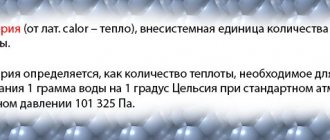- November 6, 2019
- Health
- Vlasova Anna
Regardless of whether we are sleeping or awake, our body constantly uses energy. Even in a state of complete rest, to maintain processes such as the breakdown of food, breathing, the work of internal organs and muscles, cell renewal, etc., about 20 calories are spent per 1 kg of weight in an adult.
Why you need to calculate energy consumption, how many calories you need to spend per day and where to get energy from - this will be discussed further.
BX
At school, we used to think of the Joule as a measure of energy. But regarding physiology, calculations are carried out in kilocalories. 1 kcal = 4.184 Joules. Depending on the intensity of the load, energy consumption may be more or less. But even in the complete absence of movement, the body will require a minimal amount of energy for basic physiological processes. This amount is usually called the basic exchange. It consumes 60-80% of the body’s total daily energy.
Different sexes and age groups have different basal metabolic rates. Thus, a teenager requires much more energy than an adult, and an adult woman less than a young man.
What does an approximate calculation of the body’s minimum energy expenditure per day look like?
Men spend 1 kilocalorie per kilogram of weight per hour. Accordingly, if he weighs 95 kilograms, then his basal metabolic rate will be 95 x 1 x 24 = 2280 kcal
Women consume slightly less energy - 0.9 kcal/hour for every kilogram of weight. To maintain the same 95 kg, a woman will need 95 x 0.9 x 24 = 2052 kcal.
These calculations are valid only for determining the basal metabolism. For a weight loss regime, you must use the same formula, but indicate not the current, but the desired weight. It should be taken into account that doctors do not recommend reducing the total calorie content of meals per day by less than 1200 kcal. This figure is approved by the World Health Organization. An extreme reduction in calories can lead to disruptions in the functioning of the entire body and will cause more harm than the benefits of weight loss.
Energy and people. A series of random comparisons
In physics, to solve problems, the semi-scientific “method of dimensions” is sometimes used, when knowing the dimension of the desired quantity, we can guess what to divide, add, multiply by what in order to get the correct answer. I decided to take the dimension “energy” and compare “apples with bananas”, namely the person as an energy system with other systems.
What is energy measured in?
Disclaimer: all calculations may not be exact and the main purpose is to show the order of numbers.
Man is a consumer of energy. 2 kWh, 100 W
The average person consumes about 2000 kcal per day, which gives about 2 kWh, or about 100 watts, of average power.
You can imagine that a person eats like one large 100-watt incandescent light bulb. Human energy consumption is relatively small compared to the devices that surround us. We can say that man made a technical revolution. A person takes in less energy than he uses “for himself,” even only at home (the average calculation is more than 100 kWh per month).
Man is a computing machine. 30 W
Common estimates are that the brain consumes from 200 to 1000 Kcal (stressful situations), that is, from 20% to 40% of energy, which gives an average power estimate of 30 W.
The brain is an extremely efficient system. Yes, modern laptops perform operations much better than us and the average power is about 30 W, and phones in general are 0.5-1 W. But modern video cards consume an average of 250 W and still cannot compare with the brain in the speed and accuracy of processing visual information. So, the person is a very good processor, though only for specific tasks.
Man is a battery. 10 kWh
They say a person can go without eating for 3-7 days.
It is clear that without eating, a person will begin to consume less energy for internal and external needs. We can assume that by eating double the daily norm, a person will be active for 2 days (if water is available), which gives a rough estimate of 10 kWh. If we calculate the energy intensity of a person, we can get extremely different figures; the weight of people who can live N number of days and do some useful work varies extremely from 50 kg to 150 kg. Most likely, the average energy intensity is 0.1 kWh/kg, which is neither good nor bad. We are between gasoline (10 kWh/kg) and Liion (0.1 kWh/kg), closer to batteries.
Man is a consumer of solar energy. 1-2 solar panels
Today's solar panel produces about 300 watts at peak, in moderate latitudes the average capacity is up to 20% (the sun shines only during the day and weakly).
We know that a person is short-lived, but still a battery, so on average 2 panels are enough for a person to be powered only by the sun. If we discard conventions and make small breakthroughs in technology (the use of expensive elements allows us to achieve up to 40% efficiency in panels), it will be enough for a person to wear “solar clothing” in order to receive all the necessary energy.
Man is a heater
To quote an article about clothing: at rest, the human body produces 80 watts of heat, and loses 10 watts of heat through respiration, thermal radiation - 30 watts, thermal conductivity and convection - 20 watts, and moisture evaporation - 20 watts.
It turns out that the person is an extremely “weak” heater. Home heaters consume 1 kW each and they only partially cover heating needs. Water heating and space heating are in principle the largest energy consumption in a household. Here's my annual schedule:
— Movement (transport, fuel): 8,000 kWh per year. — Electricity: 2,500 kWh per year. — Water heating and heating: 30,000 kWh per year.
It turns out that the average daily heating of water and heating takes up to 100 kWh per day, which is 50 times more than a person actually consumes.
A person is a means of transportation (car, pedestrian, bicycle)
Man, as an active living being, can move in space.
Let’s say a person can move 30 km in a day on foot and 120 km in a day by bicycle. These are not maximum values, of course, athletes run up to 100 km and drive up to 1000 km per day. Let's try to compare a person as an effective human movement system.
— A car with an internal combustion engine spends on average 5 liters per 100 km, 1 liter = 10 kWh, which gives 500 Wh per km
- Electric car -
150-200 Wh per km
- Pedestrian - 2 kWh divided by 10-50 km,
50-200 Wh per km
- Slow/small electric car -
50-100 Wh per km
- Electric bicycle -
10 Wh/km
(average speed 10-15 mph) - Cyclist - 2 kWh divided by 100-1000 km,
2-20 Wh per km
Do you know any other interesting coincidences - write in the comments. Thank you for your attention.
What happens when there is a lack of energy?
Despite doctors' recommendations, many girls, in pursuit of a thin waist, limit their diet to 1000 or even less calories. How does the body react to this?
- With a lack of incoming energy, metabolism and metabolism slow down. The body enters a state of energy saving. He also saves her on her well-being. The person becomes lethargic, passive, irritable, and absent-minded.
- The body can also react like this: “There is no food, which means we’ll go into “military mode” and stock up on it!” Thus, incoming food is stored in fat.
- After “exiting” the diet, the body still operates at a reduced basal metabolic rate, and the incoming excess goes straight into fat.
- If there is nowhere to get energy, the body will take it from its own muscle tissue.
- Lack of vitamins and nutrients.
The main components of calculating daily energy expenditure, which appear in almost any calculation system, are weight, height and activity coefficient. More advanced formulas use heart rate, muscle and fat volume, metabolic rate and even climate.
Well-known scientists in this field have derived their formulas for such calculations. The most popular of them are the Harris-Benedict and Muffin-Jeor formulas.
HOW SHOULD YOU EAT?
The highest law of medicine is to strictly follow your diet!
The word diet today refers to the diet and composition of food. There are 28 known treatment tables. Each of them is prescribed for a particular ailment. Treatment tables were developed in their original form about half a century ago. And in home dietetics, one must be guided by a menu that takes into account the doctor’s recommendations for a specific disease (set of products, features of cooking, diet). It will reflect individual health characteristics, tolerance of certain dishes, taste habits, which also must be taken into account if they do not harm health. Everyone who needs to follow a diet should be familiar with the basics of practical dietetics.
WHAT THREE RULES SHOULD EVERY PERSON BE AWARE OF?
- eat a varied diet;
- eat regularly;
- You can't be greedy when it comes to food.
Harris-Benedict formula
It was developed back in the early 20s of the 20th century and named after the scientists who discovered it. The formula calculates a person’s metabolism and gives accurate data on the number of calories he needs. Based on the results, you can adjust your diet, remove unnecessary things, review your activity level and achieve the desired body parameters.
Scientists believe that a person's energy needs depend on age, gender, current weight and height. Their formula contains more variables than the body mass index calculation. You can find several versions of this formula on the Internet. The latest and more modified looks like this:
- Men: 88.362 + (13.397 x weight in kg) + (4.799 x height in cm) - (5.677 x age (full years)).
- Women: 447.593 + (9.247 x weight in kg) + (3.098 x height in cm) - (4.330 x age (complete years)).
The result must be multiplied by the human activity coefficient (shown in the table below), after which the exact value of the daily dose of calories required to maintain the current body weight will be obtained.
| Physical activity | BX |
| Low (sedentary or lying down lifestyle) | x 1.2 |
| Low (1–3 gym workouts per week) | x 1.4 |
| Medium (intense training every other day) | x 1.6 |
| High (active work on your feet, walking, daily workouts) | x 1.7 |
| Extremely high (professional athletes) | x 1.9 |
An example of calculating the body's energy consumption per day
Woman, 34 years old, weight 64.5 kg, height 168 cm, low physical activity (office employee, sedentary job, exercises on a treadmill a couple of times a week). Basal metabolic rate: 447.593 + (9.247 x 64.5) + (3.098 x 168) - (4.330 x 34) = 1417.269 kcal.
Taking into account physical activity: 1417.7 kcal x 1.4 = 1984.18 kcal.
After many years, the Harris-Benedict equation remains relevant. Recently, American scientists confirmed its authenticity. Based on modern research and medical standards, it is 90% accurate.
Daily energy consumption[edit | edit code]
Energy consumption of human muscles, organs and tissues depending on gender, age category and body weight Table of energy consumption of human organs and tissues
Daily energy consumption
consists of three quantities:
- basal metabolic rate
- increased metabolism when eating (specific dynamic effect of food)
- increased metabolism as a result of work (physical or mental).
Daily energy consumption must be fully covered by energy obtained from food. If food is supplied in insufficient quantities, then this condition is not met and the substances of the body itself begin to oxidize. As a result, the energy balance is disrupted, the person loses weight, his performance and adaptation to adverse environmental influences decrease; A number of other phenomena arise that indicate serious health problems. Therefore, when characterizing the body’s need for food, it is necessary first of all to establish what its need for energy is. This determines the quantitative side of nutrition.
BX
determined at rest - in the morning on an empty stomach, 12-14 hours after eating, at room temperature, lying down. It characterizes energy expenditure to maintain vital functions: the activity of the cardiovascular, respiratory, excretory systems, metabolism, maintaining muscle tone.
Its magnitude depends on gender and age, on the size of the body surface in relation to mass, the state of the central nervous system, the activity of the endocrine glands, the nature of nutrition, climatic and geographical conditions, etc.
The basal metabolism in women is 5-8% lower than in men; in children - relatively higher than in adults (calculated per unit of body weight); in older people - 10-15% lower than in young people.
In relatively young people with well-developed muscles, which are energetically active tissue (athletes), the basal metabolism is higher than in overweight people with significant fat deposits.
When the external temperature rises, the basal metabolism decreases; when it decreases, it increases.
On average, the basal metabolic rate in adults is 1 kcal per 1 kg of body weight per hour (1680 kcal for a body weight of 70 kg per day).
Eating food (especially proteins) causes an increase in basal metabolism - due to increased activity of the digestive organs and the activity of certain parts of the skeletal muscles associated with food intake. On average, basal metabolism increases by 10-12% after eating.
Work (especially related to muscle activity) has a great influence on increasing basal metabolism. Quiet sitting already increases metabolism by 12-15%, standing - by 20%, slow walking - by 80-100%, running - by 400%. Sports exercises increase energy expenditure by 10-20 times or more due to increased oxidative processes in working muscles.
Daily energy expenditure and, accordingly, calorie needs for an adult vary (depending on the type of activity and age): for men - from 2350 to 3900 kcal, for women - from 2100 to 3350 kcal (including active recreation - up to 4200 and 3600 kcal respectively).
According to the theory of balanced nutrition, normal functioning of the body is possible provided it is supplied with the necessary amount of energy corresponding to its daily energy expenditure, which consists of basal metabolism, specific dynamic action of food (SDAP), physical activity, gender and age.
Basal metabolic rate (BMR)
characterizes the energy consumption in the body for metabolic processes, maintaining blood flow and respiration at rest.
Under the influence of food intake, energy consumption increases, which is associated with an increase in redox processes necessary for the transformation of nutrients in the body. With a mixed diet, this increase is 10-15% of the basal metabolism.
The increase in metabolism is also influenced by the nature of the food taken, i.e. Different nutrients (proteins, fats, carbohydrates) have different abilities to increase basal metabolism. Most of all, basal metabolism increases when taking proteins - by 30-40%. Fats increase metabolism by 4-14%, carbohydrates - by 4-7%. The increase in metabolism caused by the intake of various food components is called the specific dynamic action of food (SDFA)
.
In accordance with the amount of energy expenditure, 5 groups of the working-age population are distinguished among men and 4 groups among women; they were included in the current “Norms of Physiological Needs for the Adult Population” (1991).
Previously, the division into groups was based on certain professions, but practice has shown that the connection between energy expenditure and a person’s professional affiliation is very conditional. Therefore, in the 1991 “Norms,” the gradation of the population into groups is based on the physiological and biochemical characteristics of the body and is carried out according to BOO, taking into account the physical activity coefficient (PFA) in accordance with the recommendations of the FAO/WHO Expert Committee (1985).
Physical Activity Quotient (PFA)
is the ratio of daily energy expenditure to the value of basal metabolism. If, for example, energy expenditure on all types of life activity is 2 times higher than the BEE for the corresponding group by gender and age, then for this group the CFA will be equal to 2. The higher the energy expenditure, the higher the CFA.
The norms of physiological needs for energy and nutrients are not constant and are periodically clarified and revised in connection with changes in working and living conditions of the population, and the emergence of new scientific data in the field of food hygiene.
Table 3 Physical activity ratio (PAR) of various population groups
In table 3 presents the CFA of various population groups. Knowing the SBI and CFA, it is easy to calculate a person’s daily energy expenditure by multiplying these indicators. Higher needs for energy and nutrients are observed among young men (18-29 years old), pregnant and lactating women, and residents of the North (by 10-15%). For the latter, the “Norms” provide for the percentage of calories in proteins and fats and carbohydrates as 15:35:50.
Measuring fat volume
in the body is carried out in the following ways:
- using a special device that shows the mass of water, muscle and fat in the body. Places of fat accumulation are determined by scanning;
- by determining the ratio of waist volume to hip volume - normally it should be less than 0.85.
- using the Body Expert calculator
If body weight is increased by 10-15% due to fat deposits, one speaks of excess body weight, but not obesity as a disease. Based on severity, there are 4 degrees of obesity:
I - 15-29% g
II - 30-49%
III - 50-99%
IV - 100% or more.
Individual daily energy expenditure can be calculated with varying degrees of accuracy. This indicator can be determined more accurately if we proceed from the average statistical data of the basal metabolic rate for a person of a certain age and with a certain body weight.
Athletes have much higher energy expenditures. They especially increase due to increased training loads and increased qualifications in all sports. The energy expenditures of athletes in various sports are given in Table. 4.
Table 4 Amounts of energy expenditure of athletes in various sports
Since energy expenditure and, accordingly, caloric intake standards of an athlete depend on his weight, it is proposed to calculate them per 1 kg of body weight.
- In gymnastics, acrobatics, fencing, rugby, field hockey, volleyball, diving, equestrian sports, athletics sprinting and jumping, shooting sports, tourism, caloric intake standards are 60-65 kcal/kg;
- in track and field throwing, water polo, boxing, basketball, hockey, football, speed skating, skiing (short distances) - 65-70 kcal/kg;
- in long-distance running, swimming, weightlifting, cross-country skiing (long distance), race walking, all types of rowing, cycling - 70-75 kcal/kg;
- in marathon running - 75-85 kcal/kg;
- in multi-day cycling races - 82-90 kcal/kg.
To determine the calorie content of a diet, it is necessary to multiply the caloric content norm for a given sport by the athlete’s weight and add 10%. For example, for a sprinter, the calorie content is: 65 x 70 (athlete’s weight) = 4550 kcal; 4550 + 455 = 5005 kcal.
The need to add 10% is due to the fact that 10% of food is usually not absorbed by the body.
What is the energy expenditure in children and young athletes?
The daily energy requirement for children and adolescents is: at 7 years old - 2400; at 11-13 years old - 2850; at 14-17 years old (boys) - 3150, at 14-17 years old (girls) - 2750 kcal.
When doing athletics, you need to add energy consumption to these figures: in sprinting, jumping, throwing - at the rate of 290 kcal per 1 hour of exercise, and when running at medium distances - 450 kcal/hour.
Thus, energy consumption for male runners 14-17 years old can be: 3150 + 900 = 4050 kcal.
Energy consumption for a young athlete can also be calculated by the average calorie requirement of representatives of various sports, expressed per 1 kg of body weight per day. For example, for young men weighing 50 kg, energy consumption will be equal to: 70 x 50 = 3500 kcal + 350 (10%) = 3850 kcal.
When caloric intake corresponds (equally) to energy expenditure, body weight remains more or less constant. A significant increase in body weight with excessive fat deposition and the absence of noticeable muscle growth or, conversely, a decrease in body weight that is not explained by loss of water indicates excessive or insufficient nutrition. It should be taken into account that at the beginning of training, body weight decreases by 1-3 kg as a result of some loss of water, fat deposits and wasted energy due to unnecessary movements. Then, as training increases, the mass stabilizes or even increases slightly (due to muscle development).
The use of alcohol, tobacco products and certain drugs changes the functional state of the digestive organs and can significantly affect the absorption of nutrients. Thus, alcohol provides additional energy supply (29.7 kJ/g) and, accordingly, significantly changes the energy balance of the athlete’s body.
In this regard, when assessing the calorie content of the daily diet, an athlete’s silence even about small amounts of alcohol taken can lead to a noticeable discrepancy between the calculated and actual energy intake.
With chronic alcoholism, the processes of digestion, absorption and assimilation of nutrients are disrupted, resulting in a decrease in the nutritional value of foods.
Muffin-Jeor Formula
The formula for calculating human energy expenditure, developed in 1990, is more modern and, according to the American Dietetic Association, more accurate. It also takes into account height, weight, age and physical activity, but uses different coefficients.
| Women | 9.99 x weight in kg + 6.25 x height in cm - 4.92 x age - 161 |
| Men | 9.99 x weight in kg + 6.25 x height in cm - 4.92 x age + 5 |
How to calculate energy consumption according to Muffin-Jeor, taking into account physical activity? The data obtained must be correlated with the activity coefficient according to the following table.
| Complete lack of activity | x 1.2 |
| Low (in this case, activity should be considered low if you work out in the gym 1-3 times a week) | x 1.375 |
| Medium (3-5 lessons per week) | x 1.55 |
| High (daily strength training) | x 1.725 |
| Extremely high | x 1.9 |
Let's take all the parameters of the same woman from the previous example with the Harris-Benedict formula and look at the results using the Muffin-Jeor method:
(9.99 x 64.5) + (6.25 x 168) - (4.92 x34) - 161 = 1366.075 kcal.
Taking into account low physical activity - 1878.35 kcal.
As you can see, the difference between the calculations of the basal metabolic rate was insignificant. Approximately 50 kcal. And about 100 kcal taking into account physical activity.
1.6. Literature by section
1. Golubev V.V., Golubeva S.V. Fundamentals of pediatrics and hygiene of preschool children. - M.: Academy, 1998. - 320 p. 2. Gorshkov A.I., Lipatova O.V. Food hygiene. - M.: Medicine, 1987. - P.20-69, 134-259. 3. Kardashenko V.N. and others. Hygiene of children and adolescents: Textbook. - M.: Medicine, 1988. - P.262-304. 4. Kanevskaya L.Ya. Schoolchildren's meals. - M.: Medicine, 1989. - P.3-42. 5. Laptev A.P., Polievsky S.A. Hygiene. - M.: FiS, 1990. - P.174-226. 6. Pshendin A.I. Rational nutrition for athletes: For amateurs and professionals. - St. Petersburg: GIORD, 1999. - P.10-114.
Calculation of human energy consumption for physical activity
So, exactly how many calories are spent on different types of physical activity? We have collected their most common types in one table.
| Calculation of energy consumption during training | |
| Type of occupation | Kcal/hour for every 1 kg of body weight |
| Intensive training (tennis, circular group classes, step aerobics, exercise bike, mountaineering, running from 15 km/h, fast swimming and dancing, handball, wrestling, boxing, skiing) | 7-12 |
| Moderate exercise (swimming, walking, gymnastics, football, volleyball, uphill walking, race walking, light aerobics, cycling, hockey) | 5-7 |
| Yoga, dancing, walking, horse riding, Pilates, badminton | 3,5-5 |
| Daily routine | |
| Snow removal | 6,4 |
| Games with a child | 5 |
| Work in the country (weeding, planting, watering, cleaning leaves, etc.) | 4,7 |
| Buying groceries | 3,7 |
| Window cleaning | 3,6 |
| Wash by hand | 3 |
| Cooking | 2,6 |
| Washing/sweeping the floor | 2,4 |
| Car driving | 2,2 |
Some features of energy consumption and quantitative aspects of nutrition
People of retirement age experience weight loss, metabolic processes slow down, and the need for energy and nutrients decreases. Accordingly, lower figures for these indicators are proposed for persons over 60 years of age.
In some circumstances, energy consumption levels may be higher or lower than actual demand.
People with low physical activity are at risk of overeating and increased calorie intake. Excessive calorie consumption leads to obesity and decreased function of the cardiovascular and respiratory systems and immunity.
People with heavy physical labor often do not receive the required amount of calories from food and belong to a risk group with physical activity at the limit of physical capabilities. Eating insufficient amounts of food to cover energy expenditure leads to limited physical activity, reduced mobility in children and decreased performance in adults.
Nutritional thermogenesis
So, we already know that human energy is spent on basal metabolism (at rest) and on physical activity during the day. The third type of energy expenditure is food thermogenesis. These are the costs of warming the body, processing and disposal of food. Calculation of a person’s daily energy expenditure shows that on average 10% of all energy is spent on thermogenesis.
Food is the “fuel” for energy in the human body. It is with food that proteins, fats, carbohydrates, microelements, water and vitamins enter the body. The last three ingredients, however, have no energy value. Nutritionists say that a person needs a strictly defined proportion of BJU.
1.3. Correction of individual diet
Purpose: to determine the compliance of the student’s diet with the basic principles of the theory of rational balanced nutrition. Objectives: — consolidation of theoretical knowledge on the basic principles of rational, balanced nutrition; — consolidation of theoretical knowledge on the theory of adequate nutrition A.P. Ugolev; — acquiring skills in quantitative and qualitative assessment and correction of the diet; — to clarify the compliance of individual nutrition with the basic provisions of a healthy diet (traditional and non-traditional ideas). Required: menu layout for individual nutrition, tables of chemical composition and calorie content of food products; standards recommended by modern nutritionology for FFK students; calculator. Procedure for completing the task: using individual data on daily energy consumption and caloric intake according to the menu layout, as well as data on daily consumption of proteins, fats, carbohydrates, vitamins, minerals, adjust their consumption in accordance with recommended standards from the standpoint of value for individual health. Also determine the balance of essential nutrients in the diet. Theoretical justification of the task. Considering the value of nutrition for human health, it is necessary to periodically analyze one’s own nutrition to determine its quantitative and qualitative usefulness in accordance with the recommended standards for students. In accordance with the classification of the working-age population according to the amount of energy consumption per day, FFK students belong to the group of people with light physical labor, whose average daily energy consumption is approximately 43 kcal/kg body weight (Table 10). Consequently, the calorie content of the diet should be a similar figure (the limit of fluctuations per day does not exceed 100 kcal). The content of essential nutrients is regulated by the ratio 1:1:4 for non-athletes and 1:0.7(0.8-0.9):4(5-6) for athletes, based on the average daily protein requirement of 1.5-2.5 g/kg body weight, depending on the magnitude of muscle load.
Along with the nutritional value of the diet, the percentage distribution of calorie content by meals should be determined, i.e., the rationality of the student’s diet should be assessed, taking into account his educational and training load (Table 7). The diet, as is known, is determined by the amount and direction of the training load during the day. With one workout a day, you eat four meals a day, with 2-3 - 5-6 meals a day with the inclusion of products of increased biological value (meat, fish, nuts, honey, food additives and mixtures). An important role is played by the balance of the diet with regard to the main nutrients of animal and plant origin, which ensures optimal metabolic processes. It is generally accepted that the content of animal proteins should be 50-60% of their total daily amount, animal fats should be at least 70%, and the ratio of simple and complex carbohydrates should be 1:4. The content of foods enriched with dietary fiber should approach 500 g per day for optimal functioning of the digestive tract. A certain proportion of the daily diet (about 500 g) should be raw foods (vegetables, fruits). It is advisable to include fermented milk products in the menu (especially kefir at night). In addition, you should take into account the share of refined foods in the daily diet that are considered unhealthy (white bread, sugar-containing foods, salt, coffee, smoked meats, canned food). Their content must be minimized and gradually eliminated from the diet. Methods of preparing foods can also be analyzed from a rational point of view; The best are considered to be steaming, boiling, stewing (including fractional options), but not frying or smoking. It is necessary to clarify whether there is a habit of reheating food, which, of course, is considered unhealthy for a healthy diet. Drinking freshly prepared fruit or vegetable juices is considered a good habit. When analyzing your diet, you should pay attention to the presence of a flexible diet (taking into account the educational and training load), but at the same time this does not mean constant food “on the go”. The habit of slow, measured chewing of foods contributes to their better digestion and absorption. You can determine the amount of food eaten per day. As a rule, it ranges from 2.5-3 kg (depending on the anthropometric size of a person), with 45-50% of this amount coming from the main meal - lunch.
BJU
Let's say you calculated your ideal calorie dose for a weight loss regimen using the formulas above, and it is equal to 1450 kcal/day. This does not mean that you can completely spend them on carbohydrates and fats alone, say, on chocolate or jam, even if you meet the required figure. Proteins must also be present in the diet. The approximate ratio of BZHU should be like this:
- Proteins 30%.
- Fats 20%.
- Carbohydrates 50%.
Most energy is spent on the breakdown of proteins. Such food is easily digestible and saturates the body with useful substances. It takes 10 times less energy to process fats and carbohydrates.
Depending on the body mass index and the individual characteristics of the body, indicators of nutritional thermogenesis may be different. Thus, according to studies by Moscow scientists, in different people (with different body parameters, metabolic rates, age and gender) when eating the same food, protein thermogenesis rates ranged from 20 to 65%, and carbohydrates - from 11 to 37%.
Recent studies have shown that energy for digestion does not depend on age, but gender does matter. Women require less effort to process food than men.
1.2. Determination of daily calorie intake
Goal: to determine the compliance of actual nutrition with the basic principles of healthy eating. Tasks: - create a table of your own daily menu for meals (select the day with the most typical diet); — calculate the average daily consumption of proteins, fats, carbohydrates, calories (including by meals), compare them with standards; — determine the ratio between proteins, fats and carbohydrates, compare with standards; - determine the ratio between food substances of animal and plant origin (proteins, fats), and for carbohydrates - the ratio between simple and complex, compare with standards; — determine the content of essential vitamins in daily nutrition (A, E, C, B1, B2), compare with standards; — determine the amount of mineral salts (Ca, P, Fe), compare with standards; — calculate the amount of products containing dietary fiber (in g), compare with standards; - evaluate the diet (number of meals per day, ratio (in%) of food for each meal), compare with standards. Required: standard tables of caloric content of food products (in g per 100 g of product), sample menu layout, calculator. The order of the task. Draw up a table of your own menu in accordance with the sample, carry out the necessary calculations, analyze the obtained figures in comparison with the standards, make recommendations for strengthening the health-improving focus of nutrition. To determine the daily calorie intake, there are various methods: laboratory, menu layout (calculated). The laboratory method is used for the appropriate assessment of nutrition in the conditions of the SES laboratory, where, using special techniques, the content of nutrients in food samples taken in canteens, restaurants, and cafes in the required quantities in special dishes is determined chemically. It is taken into account that food proteins and carbohydrates supply the body with 4.1 kcal per 1 g, and fats - 9.3 kcal / g. The most convenient for educational purposes is the menu layout method. To do this, fill out the table of your own nutrition according to the sample below (Table 4). The layout is done twice: 1. The dish is divided into its constituent products, which must be expressed in grams. For this purpose, there is a table “List of dishes”, where the composition of dishes is indicated in grams per 1 serving (Table 5 and Appendix). 2. Each product is broken down into all its constituent nutrients, based on the amount of product consumed. The tables of the chemical composition of food products (see Appendix) provide figures per 100 g of product. It is necessary to recalculate the amount actually consumed.
Table 5
Then the total consumption of all nutrients (proteins, fats, etc.) and calories per day is calculated in columns, compared with the normative ones (Table 6), and an analysis is made of the balance and rationality of the actual diet (Tables 7, 8, 9). Based on nutritional characteristics, recommendations are given for improving the health of the body by optimizing nutrition.
What products require the most energy to process?
There are foods with so-called “negative calorie content”, the processing of which requires more energy than they carry. These products include: carrots, celery, spinach, cucumbers, grapefruit, radishes, ginger, seaweed and green tea. But they contain practically no proteins. The list of protein products with good thermogenesis indicators: cottage cheese, meat (turkey, chicken breast, lean beef), fish and beans.
Why calculate energy costs?
Calculation of daily energy expenditure is necessary for those who control their weight. The purposes of this control may vary. Human:
- wants to lose weight;
- support weight;
- gain muscle mass.
People gain weight when their caloric intake exceeds their calorie expenditure. Therefore, for those who want to lose weight, it is necessary to create a calorie deficit. Those who are happy with their weight, but are afraid of gaining weight, need to maintain their basal metabolism. And for those who work hard in the gym and want to build muscle, it is worth calculating energy expenditure and incoming calories, taking into account the increased amount of protein.











